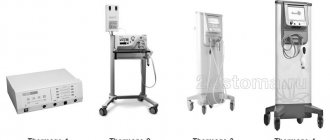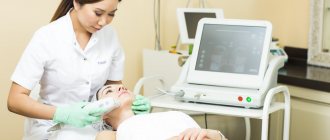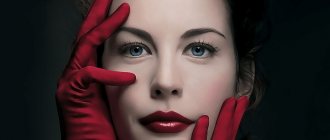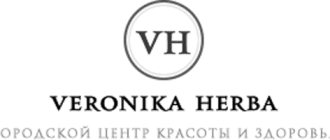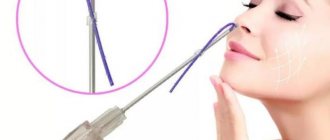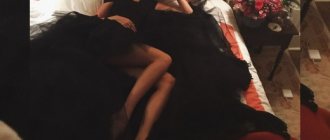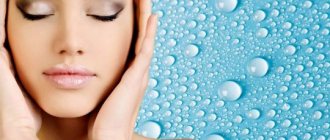To restore youthful skin, cosmetologists at the Beauty Formula Center for Aesthetic Medicine use different techniques. One of the innovative technologies is thread lifting with kogi mesothreads (cogs). They allow you to achieve a rejuvenation effect and restore skin health without surgery and a long recovery period.
They differ from other threads in the notches along the entire surface, due to which it is possible not only to achieve a lifting effect, but also to correct the shape of the face in individual areas or increase volume.
The technique is appropriate even with severe ptosis, with a double chin and jowls. A special feature is that Kogi threads for tightening can be used over large areas with a guarantee of maintaining the effect for a long time. Lifting using this technique is especially recommended for women 30-45 years old.
A short excursion into the past
Not so long ago, the use of so-called “golden” threads, which fix soft tissues in the desired position, was considered an advanced, revolutionary rejuvenation technique. Although in fact there was no talk about gold other than the name, the cleverly thought-out PR move had its effect.
Today, a more modern variation of this procedure has already appeared in the arsenal of plastic surgeons and cosmetologists, which provides not only a lifting effect, but also all the benefits of mesotherapy.
The “3D Mesothreads” method of face lifting and wrinkle elimination came to us from South Korea - it was originally developed specifically for the thin and sensitive skin of women in East Asia, but, thanks to its high efficiency and low trauma compared to surgical techniques, it instantly gained popularity in Europe among both women and men.
What do mesothreads consist of and how do they work:
Mesothreads are threads made of absorbable materials (caprolactone, polydioxanone, polylactic acid), attached to the finest needles made of high-quality steel, or located inside a guide cannula.
When placing threads, two main effects :
Mechanical lifting is observed immediately upon installation: the soft tissues of the face and body are tightened and fixed in the desired position. At the same time, both age-related wrinkles (which have formed over time) and structural ones (which are a feature of the facial structure) are equally effectively eliminated.
Further, under the influence of the skin’s own enzymes, the threads gradually dissolve. The period of biodegradation of threads is different and depends on the materials from which they are made, from 4 months to one and a half years. And in their place, a kind of connective tissue frame is formed, which maintains the result of the tightening for 2-4 years. After this period, a repeat procedure will be required.
Histological lifting is rejuvenation at the cellular level, as after conventional mesotherapy (hence the name) - during the resorption process, they release biologically active substances that activate skin cells to produce their own collagen and elastin, improve tissue oxygenation and, as a result, skin turgor and elasticity increase, the skin begins to “glow from within.”
Important!
Not all types of threads can provide the effect of mechanical lifting.
Let's find out why? If you think that any thread can give lifting, then you are mistaken.
There are true lifting threads in the lines of threads Dermafil Happy Lift, Aptos, etc. They are distinguished by the ability to create using virtual loops - reference points - thread fixation points, so the thread does not “float” freely in the tissues, but is firmly fixed in them, which allows maximum effect of mechanical lifting. In addition, the advantage of the threads is their thickness and the strength of the notches. Each notch is attached to the thread separately, and is not “cut” from the thickness of the thread itself, thereby thinning it. Thanks to this, the notches firmly “cling” to the fabrics, preventing them from “slipping” to the bottom.
Reinforcing threads are threads that do not provide lifting, but only help create a strong frame in the skin and improve its quality. These include linear mesothreads - the threads with which the “era” of thread lifting began. As well as their various derivatives - braids, springs and so on - due to the fact that the threads are thick and have an “uneven” texture - they give a more pronounced reinforcement effect.
Kogi - despite the fact that they are called lifting threads, they are not classified as such. They can be called pseudo-lifting - thanks to the notches, they allow you to “pick up” tissues and move them in the desired direction. The “pseudo-lifting” effect is observed for 1-2 months due to the presence of post-traumatic edema and slight tissue movement. But when the tissue is completely restored, the lifting effect “evaporates.” And here’s why - these threads do not have fixation points in the tissues, they are freely located in them and the second important factor is “weak notches”, they are carved on the thread itself, like “notches on a tree trunk”, which significantly reduces their ability to firmly fix fabric and, moreover, the thread itself becomes thinner and less durable. As a result, fabrics, especially heavy ones, happily “slide” to the bottom.
The advantage of these threads is that, thanks to the notches, they cause greater tissue trauma compared to monofilaments, and, accordingly, a greater tissue response. Therefore, the effect of the so-called vector lifting is “A+”.
Important!
There are a number of techniques used by specialists at our center that make it possible to prolong and make the mechanical lifting effect more durable even with this type of thread. True, a significant disadvantage of this is the lengthening of the rehabilitation period.
How is a facelift performed using mesothreads?
Many cosmetologists are ready to drag a patient into a thread lifting procedure right during the initial consultation, which should immediately alert you. There must be a preparatory period before the procedure. For example, in order to prevent exacerbation of herpes, it is advisable to start taking antiviral drugs, for example, Acyclovir or Valaciclovir, 1 day before the procedure (a total course of 3-4 days). In addition, given that mesothreads are most often inserted into tissues using sharp needles rather than a blunt cannula, there is a very high risk of hematomas.
Therefore, many doctors recommend that patients, 2 days before the thread lifting procedure, start taking a drug that accelerates blood clotting (if there are no contraindications), for example, the drug Dicynon - 1 tablet. 2 times a day. To prevent infections, it is important to thoroughly remove makeup before the procedure. Installation of mesothreads can only be carried out in a treatment room; accordingly, there must be a sterile table. The procedure itself should be performed by a doctor wearing sterile gloves, and not regular “examination” gloves.
Antiseptic skin treatment is carried out only with alcohol-containing solutions, and not with the usual chlorhexidine solution. As for anesthesia, most cosmetologists use local anesthesia in the form of an anesthetic cream or gel based on lidocaine, which is applied for 20 minutes. Of course, this is not the best type of anesthesia, but cosmetologists rarely know how to do it any other way. For patients with a high threshold of pain sensitivity, it is advisable to do cannula anesthesia, when an anesthetic solution is injected through 1 injection point using a cannula (in the area of the entire intervention zone).
Progress of the procedure –
Typically, mesothreads are inserted under the skin with special thin sharp needles, and only threads of the COG type from some manufacturers are inserted not with needles, but with a blunt-tipped cannula. The latter are much safer, because... they have a blunt end that pushes tissue apart rather than cutting (unlike a pointed needle). As a result, the cannulas do not injure blood vessels and nerves; as a rule, there are no hematomas or swelling after them. The length of the mesothreads and their number are selected individually.
Technique for introducing mesothreads –
Conventional thin mesothreads are inserted strictly subdermally (to a depth of 1-2 mm). The ideal depth corresponds to the boundary between the reticular and papillary layers of the dermis. The needles are inserted parallel to the skin surface at a specified length. If it is planned that the threads will be located parallel to each other, then the distance between them is usually from 0.5 to 1.0 cm. But the threads can also be implanted with intersecting trajectories. After all the needles are inserted into the tissue, the doctor alternately presses the skin in the area of the tip of each needle, which makes it possible to fix a piece of mesothread in the tissue, and removes the needle. The mesothreads remain inside the skin.
Mesothreads: video
The number of threads used - the number of mesothreads depends on the age and condition of the skin, on the number of problem areas treated in 1 procedure. On average, 10 long threads are installed on the nasolabial folds on each side, and 5-10 on each side on the folds running from the corners of the mouth to the chin. In the area of the outer corners of the eyes - 6-8 threads on each side. In the forehead or submandibular area - a total of about 16-20 threads. But threadlifting the oval of the face will require about 30-40 threads.
Why is there no effect?
More than once in my practice I have heard that inserting threads has no effect. This has no effect, and simply in pursuit of making the procedure cheaper, some doctors use threads from the “just to deliver” category. And unfortunately, in most cases, it is you, our dear patients, who provoke them to this, wanting to do the procedure for “pennies”
Important!
The thread lifting procedure, especially with true lifting threads Dermafil Happy Lift, Aptos, etc., will not be cheap. Therefore, you need to understand for yourself - either I put threads or I don’t.
Let's summarize the results of incorrect use of threads, which will not have a lifting effect:
- Using reinforcing threads to achieve lifting
- Using an insufficient number of threads for lifting purposes. It is especially touching when they place one or two threads on each side. And in the best case, it’s good that these will be so-called kogi, but sometimes they are just monofilaments. In this case we are talking only about pseudo-lifting threads
- Incorrect installation of threads - either too deep or superficial. Incorrectly selected reference points when installing lifting threads.
- Incorrectly selected patients - patients with stage III or IV gravitational ptosis are unlikely to be satisfied with the procedure.
At what age should threads be used?
This is perhaps the most frequently asked question.
From the point of view of the law - from 18 years of age. And from an aesthetics point of view, the first indications for thread lifting most often appear around the age of 30: wrinkles deepen, the oval of the face “floats”, and the skin loses firmness and elasticity. However, these processes are strictly individual for each person, and the time for correction can come either at 25 or 40 years.
The concept that thread lifting is indicated only when the face loses its youthful oval and the hated jowls begin to bother everyone, the nasolabial and labio-mental folds are deeply formed, and the face becomes “square” is long outdated.
You need to understand that thread lifting is not plastic surgery, we do not cut off the skin, but only move the tissue, due to which the skin contracts and activates histological lifting.
It takes time to start all these processes.
In this regard, the result should be assessed no earlier than six months later, or better yet, a year later.
Therefore, if you are over 50 and finally decided that it’s time to get threads, and that after that you will look 30, then you are too late. We will not say that there will be no result, it will be, but not what you expect.
In threadlifting, as in many other procedures, there is such a thing as the quality of the source material. The better it is, the more pronounced the result.
Therefore, as soon as the first signs of gravitational ptosis appear or do not appear at all, but you are already over 25, it is time to think about placing threads. This is how you will prolong your youth for many years.
Rehabilitation period.
Rehabilitation depends on the type, quantity and technique of inserting the selected threads, as well as the goals we are pursuing.
It may not exist at all, just a couple of small bruises that do not affect the quality of life, or it can last from 2 weeks to several months. During this time, it is only necessary to protect the treated area from sudden and intense movements, in particular, to refrain from active facial expressions, and chew slowly and carefully while eating. Avoid visiting baths, saunas, gyms, and solariums. Also, for a period of up to 2 months, it is advisable to exclude all manual procedures in the area where the threads are installed.
Important!
Do not self-medicate!
During this period, you should follow all the recommendations given to you INDIVIDUALLY and introduce certain restrictions into your usual lifestyle, about which you will be very carefully informed before the thread lifting procedure.
Which category of patients do we recommend thread lifting?
We recommend thread lifting to “advanced” users of cosmetic procedures, those who do not faint (to our surprise, there are such patients) at the word “Threads” and are ready for the rehabilitation period. For those who do not want to lie on the operating table, or understand that the number of braces is limited, so they are in no hurry to do the first one.
Happy lift threads are an ideal means of preserving youth for those who avoid or postpone serious surgical interventions.
The procedure occupies an intermediate position between cosmetology and plastic surgery. Allows you to achieve pronounced correction results; no lengthy preparation is required, and the procedure itself will take no more than an hour. The effect of the procedure is visible immediately, intensifies within 3 months and lasts from 1 to 3 years.
Happy lift is used for:
- oval face lift;
- to eliminate nasolabial folds;
- to align the contour of the lower jaw;
- for eyebrow lifting;
- to eliminate wrinkles on the neck;
- against early skin photoaging;
- to give expressiveness and relief to a “flat” face;
- for the correction of asymmetries - unilateral ptosis of the eyebrows and face;
- in medicine - for aesthetic correction of facial nerve paresis, etc.;
- thickening of the skin of various parts of the body.
H appy Lift threads made of and what are the advantages ?
- The most effective type of non-surgical lifting.
- Allows you not just to tighten, but to truly model 3D volumes of the face.
- Happy Lift threads are Italian threads. They have the CE safety mark. This means that the manufacturer guarantees the quality of the product and high production standards, including sterilization and packaging. Approved for use in the Russian Federation
- Thanks to the patented technology of applying notches, each notch is applied to the thread separately, due to which the thread has high strength and is perfectly fixed in the tissues, providing pronounced tissue movement and a long-lasting correction result
- They consist of caprolactone coated with polylactic acid on top. Caprolactone has been used in medicine for more than 50 years as a suture material. It is inert and safe.
- Polylactic acid in the threads intensively moisturizes the skin and significantly improves its quality. After installation of the threads, the skin is tightened, thickened, smoothed and takes on a radiant appearance.
- Does not require anesthesia. Local anesthesia is used for the procedure.
- Biodegradability. 12-18 months after installation, the threads are completely absorbed, and no foreign substance remains in the tissues.
- The soft fibrous capsule, which during this time is formed in place of the thread, maintains the facial tissues in a youthful position for another 2 years.
Introduced into the skin, these threads slow down the passage of time by 3-5 years, especially in combination with other cosmetological techniques, such as mesotherapy, biorevitalization, etc.
↑ Indications for use
The first age-related changes in the skin become noticeable by the age of 30. But a cosmetologist always recommends starting with less drastic methods of correcting wrinkles and facial contours. These are peelings, masks, botulinum toxin injections, massage and others. When primary remedies lose their effectiveness, a facelift with threads becomes relevant.
The procedure is indicated for the following imperfections in appearance:
- shallow expression wrinkles;
- double chin;
- drooping eyelids;
- sagging eyebrow line;
- pronounced nasolabial folds;
- loss of skin elasticity, sagging;
- folds on the neck;
- unclear oval face;
- muscle deficiency.
Types of Happy Lift threads that we use in our work.
MesoСogs is a thread for improving the quality of skin not only of the face, but also of the body. A 50 cm long thread is actively used to eliminate sagging neck, décolleté, abdomen, inner surface of the arms and thighs. The skin becomes thicker, color improves, and blood supply increases.
Free Floating – translated from English as “free floating”, that is, without a fixation point. These are threads with converging notches that are inserted into the skin using a guide needle. They are used to reinforce the entire face or individual parts of it, as well as to eliminate sagging skin on any part of the body. They do not have a pronounced lifting effect.
Double Needle is a thread attached at both ends to the ends of two needles. Allows you to create a strong fixation point and move tissue to this point. It is a true lifting thread. Depending on the area of installation, we achieve the elimination of various aesthetic defects: eyebrow lifting, smoothing out “wrinkles of sadness” and nasolabial folds, eliminating a “double chin” and jowls, recreating a youthful oval of the face.
Boca thread -. The first thread for correction of the oral area. Threads with diverging notches, introduced into the skin using a guide needle, allow you to create a clear contour of the lips, expand their corners and also eliminate purse-string wrinkles.
Result of the procedure
Using Cog threads for a facelift allows you to achieve a number of effects:
- reinforcement and strengthening of the skin frame;
- correction of the oval and contours of the face, enhancing their clarity;
- skin tightening and lifting;
- formation of an attractive and expressive cheekbone line;
- smoothing folds and wrinkles;
- eliminating ptosis and sagging skin, improving its turgor and tone;
- skin rejuvenation by stimulating neocollagenogenesis and elastin formation;
- elimination of asymmetry of facial features.
The result of the procedure is visible immediately after its implementation and reaches a maximum after 1.5 months. The effect of face lifting and rejuvenation lasts for up to 1-2 years.
Reinforcing and pseudo-lifting mesothreads.
So, their main differences from true lifting threads are as follows:
Threads consisting of polydiaxonone (PDO)
- Polydioxanone is a hypoallergenic, non-toxic, pyrogen-free surgical suture material that causes a very weak tissue reaction during resorption.
- The high rate of biodegradation of mesothreads ensures mild neocollagenosis without compromising microcirculation and tissue vascularization in the installation area. After 180-240 days after the procedure, mesothreads completely biodegrade, breaking down into carbon dioxide and water familiar to the body (100% biocompatibility with tissues). In the area where the mesothread is installed, a slight compaction of connective tissue remains, which continues to perform a “frame” function for 12-18 months.
Due to such a mild and short-lasting effect, we cannot obtain a true lifting effect.
Effects when installing mesothreads:
- biostimulation (biorevitalization);
- reinforcement (remodeling);
- vector lifting.
Opinion of cosmetologists
On forums, cosmetologists share their experience of working with kogi mesothreads.
The review states that if fibrosis forms , it means that low-quality material was used, or the patient has a connective tissue disease.
A participant writes about the effect of mesothreads on a slight overhang of the middle third of the face.
The user asks which threads are best to work with and where to get training.
What complications and side effects occur with thread lifting?
This question worries everyone who has decided to undergo a thread lifting procedure.
Allergic reactions - polydiaxonone and caprolactone have been used in medicine for a very long time as biodegradable suture material. Therefore, when using them, there are practically no allergic reactions.
Contouring – In patients with thin skin, even if we place the threads correctly, the thread may contour. We warn you about this in advance, and it would be advisable for such patients to refuse the procedure.
Hypertension and folds - excessive lifting of soft tissues leads to an unnatural, “overstretched” appearance, especially in the lower third of the face. As a rule, it goes away on its own after 7-10 days from the procedure. The reason for excessive lifting is the presence of skin folds after the procedure. These two undesirable effects will always be present if we want to get the maximum effect from the procedure and achieve a lasting effect due to retraction (movement and contraction) of the skin. We don’t cut off the skin, so it has to “go somewhere” and this happens precisely as a result of the formation of skin folds. The folds will last on your face from 2 weeks to a couple of months, depending on your goals.
Therefore, the formation of these effects is one of the special tightening techniques and is discussed before the procedure.
If you “catastrophically” do not want wrinkles after the procedure and have an overstretched face, then you can do without this, but do not expect a pronounced and lasting lifting effect.
Hematomas, swelling and pain in the places where the threads are inserted are absolutely normal. Thread lifting is not a facial massage, but an invasive, traumatic procedure. All these phenomena do not threaten your health, do not bring significant discomfort, but of course they spoil your appearance.
They take place within two weeks. For some it is earlier, but for others the time is longer - it depends on the individual characteristics of the body and how correctly you follow the recommendations given to you
Purulent inflammatory processes in the area where the threads are installed occur as a result of infection entering the puncture sites. This is possible if the rules of asepsis and antisepsis are violated, but much more often happens due to the fact that the patient does not behave carefully enough in the first days after the procedure. It is treated with an individually selected course of antibiotics.
Retraction along the thread - occurs as a result of surface installation of threads. The level of placement of the threads is the border of the dermis and subcutaneous fat. If the thread is located intradermally, then the result is skin retraction—the formation of so-called “traces” of threads. In this case, the thread will have to be removed, and the sooner the better, so as not to complicate your life in the future by delaying this complication.
Capsular contracture (like the one that can occur in the breast, around the implant), allegedly forming around the threads - a “horror story” spread by incompetent doctors or patients (like the one that can occur in the chest, around the implant) has no basis in reality grounds. This is confirmed not only by theory, but also by practice: surgeons who performed facelift operations on patients who had previously installed threads for themselves, and had a chance to see the situation from the inside, testify to the absence of any hint of a fibrous capsule.
Possible consequences
Side effects may occur after the procedure of inserting kogi threads. They can be local and short-term, which will go away on their own within a few days or a week.
Side effects include:
- Pain;
- Swelling;
- Seals at injection sites;
- Bruises and hematomas;
- Redness and inflammation;
- Unnatural skin color in areas of braces;
- Subcutaneous folds and bumps;
- Asymmetry, depressions and gathers.
More serious and delayed side effects include:
- Internal tissue inflammation;
- Neuropathy;
- The appearance of scars;
- Broken thread;
- Cutting through the skin with a thread;
- Migration of material to the surface of the skin;
- Transillumination of inserted threads;
- Non-absorbable obvious irregularities.
In case of serious and persistent violations, you should contact a specialist. In severe cases, mesothreads are subject to removal and a subsequent course of antibiotics and antibacterial drugs.
The main factors excluding thread lifting:
The first and main contraindication is the patient’s overestimated attitude towards the procedure, the second is the lack of psychological attitude to competently survive the rehabilitation period
Well, and of course such general contraindications as:
- pregnancy and lactation;
- the presence of previously installed implants or non-absorbable materials (threads, gels) in the correction area;
- tendency to form keloid and hypertrophic scars;
- feverish state, increased body temperature;
- inflammatory processes on the skin and under it in the correction area, including herpetic rashes;
- chronic diseases in the acute stage;
- cancer and autoimmune diseases;
- diabetes;
- taking anticoagulants or bleeding disorders;
- epilepsy;
- psychical deviations;
- age up to 18 years.
Iatrogenic complications
If iatrogenic complications are considered in a narrow sense - as a doctor’s mistake when performing a procedure, then they mainly come down to the incorrect use of the technique for installing threads.
It is known that the installation of threads with protrusions is effective only in kinetically inert zones [5]. However, if the correction zones are chosen unreasonably, the thread may pass through the moving parts of the face. Violation of the general rules for installing threads - irrational choice of the fixation point, exit point, depth of the thread can lead to damage to the blood vessel, injury or compression of the nerve, and disruption of the integrity of other structural formations of the face and body [18]. According to the experience of our clinic’s specialists, a deeply located thread promotes protrusion of the tissue, while a superficially located thread, on the contrary, causes depression. The doctor’s ignorance of this pattern due to his lack of qualifications can cause cosmetic defects (Fig. 7).
| A | B |
Rice. 7. Violation of the rules for the depth of insertion of the cannula: A – skin retraction due to superficial insertion of the end sections of the threads; B – restoration of facial contours immediately after removal of the end sections of the threads
The doctor's qualifications are the most important factor. M.A. Sulamanidze et al. We are confident that the main reason for complications and unpleasant consequences is the lack of special training among doctors [5]. The Society of Specialists in Medical Thread Technologies (OSMNT) is actively involved in solving this pressing problem, providing additional professional training for doctors at the North-Western Educational Medical Center. Lectures, master classes, round tables and seminars on traditional and new methods of thread rejuvenation lay the foundations for high-quality procedures, treatment and prevention of complications.

